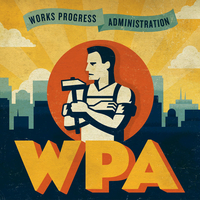 | Back to e-WV
| Back to e-WV
 The West Virginia Encyclopedia
The West Virginia Encyclopedia
 | Back to e-WV
| Back to e-WV
 The West Virginia Encyclopedia
The West Virginia Encyclopedia

In 1935, responding to a request by President Franklin D. Roosevelt, Congress established the Works Progress Administration to provide work for the unemployed of the Great Depression. Based on the belief that direct relief payments to the able-bodied unemployed were demoralizing, the WPA sought to provide government jobs at wages higher than the dole but lower than prevailing wages in the private economy.
National WPA director Harry Hopkins appointed Frank Witcher McCullough of Huntington as the West Virginia administrator. McCullough was succeeded by Joseph Newman Alderson of Alderson in 1937. The agency ceased operations in 1942.
West Virginia was one of the handful of states in which there were serious charges of political interference with the WPA. A federal investigation in 1936 found no basis for the worst of the charges, which were made by the maverick Democratic senator, Rush D. Holt, on the floor of the U.S. Senate and on a national radio network. Both Democratic governors of the period, Guy Kump and Homer Holt, resented that control over the agency’s considerable patronage rested largely in the hands of senior senator Matthew M. Neely, who was more sympathetic to New Deal programs.
Despite the bitter conflicts over the agency among the state’s leading politicians, the WPA met a critical need, putting many of West Virginia’s unemployed to work on a variety of projects in construction, rehabilitation, public health, recreation, conservation, rural road improvement, urban street repairs, and education. Recognizing that unemployment reached beyond blue-collar workers, WPA also generated projects for writers, teachers, artists, and musicians. For many West Virginians, WPA provided a job and hope for the future during hard times.
Although most were small projects in which most of the money would be used for wages, some of WPA’s endeavors had more enduring value, such as the South Side Bridge in Charleston; a therapeutic center for the Morris Memorial Hospital for Crippled Children in Milton; an African-American high school in Morgantown, and various other public buildings around the state; the building and improvement of airports; and the writing of West Virginia: A Guide to the Mountain State. More capital-intensive undertakings were handled by the Public Works Administration (PWA).
Written by Jerry Bruce Thomas
Thomas, Jerry Bruce. An Appalachian New Deal: West Virginia in the Great Depression. Lexington: University Press of Kentucky, 1998.
Brock, William R. Welfare, Democracy, and the New Deal. Cambridge: Cambridge University Press, 1988.